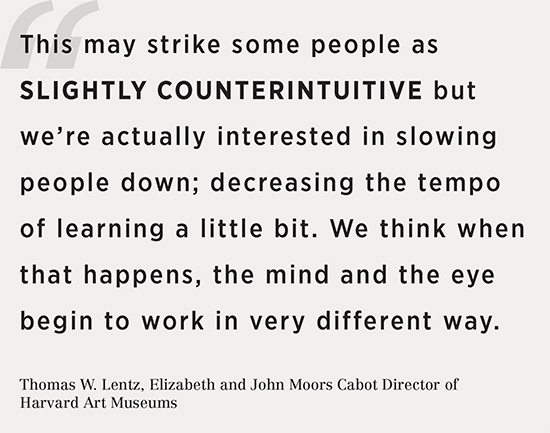
I’m fascinated by this quote. It was made in reference to Harvard’s design intent for the newly re-opened Harvard Art Museums. Thomas Lentz is the Director of the Harvard Art Museums. Slowing down…what are the ramifications of slowing down in the modern creative workplace? How do we find time in high-pressure design schedules to be innovative; to produce well-reasoned, well-rounded designs?
To say that one needs to slow down to be innovative doesn’t seem quite accurate. Take the medical industry for example. Some of the greatest advancements in medicine have occurred on the battlefield where taking your time isn’t really an option. While quick thinking is the key to survival there – a lot of arms and legs were lost in the fray. To draw this simile to the design profession is risky but not entirely inappropriate.
The time associated with the design phase of a project seems to have shortened in recent years; at least that’s been the experience of this designer. Interestingly though, drafting using the current software of choice seems to be the antithesis of speedy drafting. In the document production race AutoCAD is the hare; Revit is the tortoise. Sure, Revit will undoubtedly win the race but its interface isn’t the most intuitive or crisp.
Our industry commitment to Revit Technology is clear and well founded. That it has taken years to integrate the technology into the design practice stands in stark contrast to that required for AutoCAD. Back-in-the-day AutoCAD training consisted of being handed a chair and a computer. Revit training over the course of my career, please excuse the use of my own experience here, has been something more involved and requires freshening up from time to time. It takes a significant investment in time and we all know that time is money.
In my professional life outside of PAYETTE I worked in a practice where I had the opportunity to manage the first project in that office to use Revit from schematic design through construction administration. The journey was a long one and rife with battles. Fortunately the Revit has evolved. I recommend that IT staff do not say “…call me anytime you have a Revit problem” because at that time there were problems and I did call – that the unfortunate director of IT rushed to the emergency room (non-Revit-related injury) did not register with the design team. What can I say, there was a deadline, I’m not proud.
Since my days as a “power-user” I’ve sort of fallen behind the Revit Wagon Train. I currently work in Revit but don’t count my skills as equal to the Revit wizards that surround me. Sure, I can get some work done but, the use of the software brings little joy. My running joke with coworkers: Revit to Hal is like Dementors to Harry Potter without a wand. It leaves me catatonic and blinking, unable to accurately account for the time that has passed during its use.
But its value is clear. It asks a designer to think about the nature of what each line (or component) means. It has coordination built into it, it assists in visualization, and it requires a user to slow down. How we use that expanded time and interface to our creative advantage remains to be seen, I think. Within the Revit time warp it’s important for our industry to not create legions of Revit software technicians but rather use Revit as one tool to share, teach and create form and space.
The real creativity realized by slowing down may be in how we mentor. How do we guide talent when that talent is often focused on his or her computer? More observation of the process is the key. Look to see how the design process flows and examine the results. Review the designs using more than one medium: print and pull out a roll of trace. Teach the ability to share ideas with a client not only via computer but also with face to face interactive work. Of course, this may be viewed as old school and I suppose it is. Of course, finally, we must embrace the technology even though it’s often frustrating to do so. With this technology and careful attention to those who use it great things can happen.


